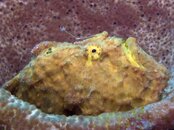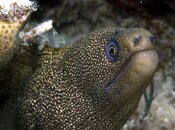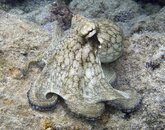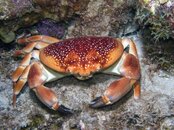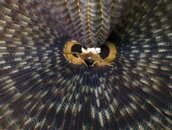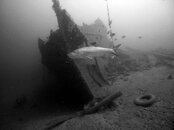You are using an out of date browser. It may not display this or other websites correctly.
You should upgrade or use an alternative browser.
You should upgrade or use an alternative browser.
Dx-1g?
- Thread starter jon m
- Start date
Please register or login
Welcome to ScubaBoard, the world's largest scuba diving community. Registration is not required to read the forums, but we encourage you to join. Joining has its benefits and enables you to participate in the discussions.
Benefits of registering include
- Ability to post and comment on topics and discussions.
- A Free photo gallery to share your dive photos with the world.
- You can make this box go away
The last few dives I shot all pictures at the lowest ISO-setting (80) and that changed a lot. The quality of the pictures is now what I expect them to be. Before I shot default at ISO 200 and that creates a grainy background and loss of detail in the foreground.
I am pointing the strobe from the (left) side towards the subject; if I shoot macro I have the strobe almost resting on top of the lens; in that case I use the smallest opening that is available to get more depth of field and to avoid overexposure from the flash. But, as Air One said, you can easily check the result on the LCD and try another shot.
A few pictures of this weeks dives:
I am pointing the strobe from the (left) side towards the subject; if I shoot macro I have the strobe almost resting on top of the lens; in that case I use the smallest opening that is available to get more depth of field and to avoid overexposure from the flash. But, as Air One said, you can easily check the result on the LCD and try another shot.
A few pictures of this weeks dives:
Attachments
diver 85
Contributor
gustele, good shots.....Out of curiosity, why did you go to 80 vs 200 ISO??....
Air One
Contributor
Out of curiosity, why did you go to 80 vs 200 ISO??....
The last few dives I shot all pictures at the lowest ISO-setting (80) and that changed a lot. The quality of the pictures is now what I expect them to be. Before I shot default at ISO 200 and that creates a grainy background and loss of detail in the foreground.
I do agree with you, and I also shot at 80 or 100.
Except, once again, in B&W of course.
There are circumstances that I shoot at ISO800 max and that is when shooting under low light conditions with natural light to avoid backscatter. With my previous camera I converted such shots to B&W, but now while shooting RAW I am able to bring some color back into the picture.
Then you get a shot like this:

Then you get a shot like this:

Air One
Contributor
For this kind of pics I prefer the black & white and i also use the high ISO.
The raw mode is also ( OMHO) a default on this camera, recording takes about 3-5 s !
I love that pic, If you could not have cut the front mat ! I can imagine that you were shooting the big fish in front ?
What is this wreck ? And where is it ?
The raw mode is also ( OMHO) a default on this camera, recording takes about 3-5 s !
I love that pic, If you could not have cut the front mat ! I can imagine that you were shooting the big fish in front ?
What is this wreck ? And where is it ?
Erwan
I work almost every Sunday on this wreck to keep it clean, to document it and to do guided tours for tourists. It is the Mediator, a archeological wreck (1884) in the harbor of Willemstad, Curacao. There is an almost monochrome (not B&W, but greenish) version of this picture on the home page of my website Welcome to the Curacao Diving Paradise - Curacao Diving Paradise. I agree that sometimes B&W or monochrome pictures are a better choice. That greenish version made it to the frontpage of one of our newspapers. There is also a section of that website devoted to this wreck with lots of historical information and (B&W) pictures.
The B&W version of the one with the tarpon is attached (after uploading it came out a bit too dark).
I work almost every Sunday on this wreck to keep it clean, to document it and to do guided tours for tourists. It is the Mediator, a archeological wreck (1884) in the harbor of Willemstad, Curacao. There is an almost monochrome (not B&W, but greenish) version of this picture on the home page of my website Welcome to the Curacao Diving Paradise - Curacao Diving Paradise. I agree that sometimes B&W or monochrome pictures are a better choice. That greenish version made it to the frontpage of one of our newspapers. There is also a section of that website devoted to this wreck with lots of historical information and (B&W) pictures.
The B&W version of the one with the tarpon is attached (after uploading it came out a bit too dark).
Attachments
Air One
Contributor
Do you use an additional WAL ?
Yep, I bought the Sea&Sea WA lens for the DX-1G; it is a 16 mm (35mm equivalent) which gives a 85 degrees field of view under water; it is a very good wide angle lens, far wider that the WA-lens that I had in combination with the Sealife DC500. It is perfect for panoramic shots to show the slope of the reef or the coral coverage. It is also good for getting closer to a large subject when using the strobe. In that case I use the diffuser on the strobe to get sufficient light coverage. When not in use it is sitting on the lens caddy on the strobe arm.
Air One
Contributor
I 've got the same lens, I should use the difuser also.
Similar threads
- Replies
- 2
- Views
- 358
- Replies
- 0
- Views
- 267
- Replies
- 2
- Views
- 927




